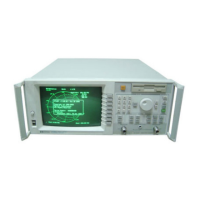I
-
Front Panel
lbur
I
The CRT Display The analyzer’s large
CRT
displays data, markers, limit lines, Instrument BASIC
IIBASICI
programming coda, softkay menus and measurement parameters quickly and clearly. Refer to
“Display’ in Chapter 8 for more information.
e
(m]
The
(w)
key simpliiias measurement setups. The begin key allows quick and easy
selection of basic measurement parameters for a user-specified class of devices
[e.g.,
filters,
amplifiers, or
mixarsl.
For example, when making a transmission measurement, selecting
Filter as Your device type puts the analyrer into narrowband detection mode,
maximizin!
measurement dynamic range. In comparison, selecting Mixer as Your device type puts the
analyzer into broadband detection mode, enabling frequency translation measurements. This
capability allows new users to start making measurements with as few as four keystrokes.
3
MEAS
The measure keys select the measurements for each channel. The analyzer’s measurement
capabilities include transmission, reflection, power, conversion loss, and AM delay
IOptions
IDA and
IDB
onlyl.
4
SOURCE
The source keys select the desired source output signal to the device under test, for
example, selecting source frequency range or output power. The source keys also control
sweep time, number of points, and sweep triggering.
6
CONFIGURE The configure keys control receiver and display parameters. These parameters include
receiver bandwidth and averaging, display scaling and format, marker functions, and
instrument calibration.
B SYSTEM The system keys control system level functions. These include instrument preset, save/recall,
and hardcopy output.
HP-18
parameters end
IBASIC
are also controlled with these system
keys.
7
The Numeric Keypad Use the number keys to enter a specific numeric value for a chosen parameter. Use the
[ENTER)
key or the softkays to terminate the numeric entry with the appropriate units.
You can also use the front panel knob for making continuous adjustments to parameter
values, while the
m
and
0
keys allow You to change values in steps.
~I(JJARDKEYS)
Hardkays are front panel keys physically located on the instrument front panel. In text,
these keys will be represented by the key name with a box around it
such as:
L-j.
3
Softkep;e
Softkeys are keys whose labels are determined by the analyzer’s firmware. The labels are
displayed on the screen next to the 8 blank keys next to the display screen on the analyzer.
In text, these keys will be represented by the key name with shading behind it such es:
Snsep
Tim.
2-3
-1

